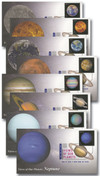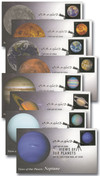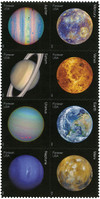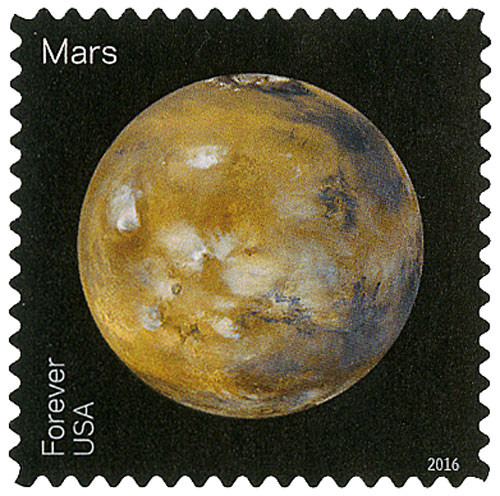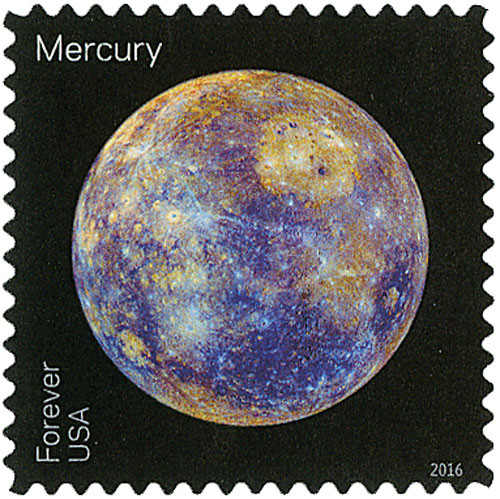
# 5069-76 - 2016 First-Class Forever Stamp - Views of Our Planets
US #5069-76
2016 Views of Our Planets
- Issued alongside the 2016 Pluto Explored stamps to commemorate space exploration in our Solar System and New Horizon spacecraft’s flyby of Pluton in 2015
Stamp Category: Commemorative
Value: 47¢ First Class Mail Rate (Forever)
First Day of Issue: May 31, 2016
First Day City: New York, New York
Quantity Issued: 40,000,000
Printed by: Ashton Potter (USA) Ltd.
Printing Method: Offset
Format: Panes of 16
Tagging: Nonphosphored type III, spot tag
Why the stamps were issued: To honor NASA’s space exploration efforts within our Solar System that have given us up-close images of every plant and – as of 2015 – dwarf planet Pluto.
About the stamp designs: Each of the eight stamp designs pictures a planet in our Solar System. According to the USPS, “Some show the planet’s ‘true’ color – what we might see with our own eyes if traveling through space. Others use colors to represent and visualize certain features of a planet based on imaging data. Still others use the near-infrared spectrum to show things that cannot be seen by the human eye in visible light.”
First Day City: The First Day of Issue Ceremony was held at the Javits Center in New York City during the World Stamp Show 2016.
History the stamp represents: Spanning nine billion miles, our solar system is home to hundreds of thousands of celestial bodies including dwarf planets, moons, comets, and asteroids. The largest and most studied however, are the eight planets.
The four planets closes to the Sun (Mercury, Venus, Earth, and Mars) are known as terrestrial planets, because they have solid rocky surfaces. The next two planets, Jupiter and Saturn, are known as gas giants because they do not have solid cores. Finally, the two farthest planets from the Sun, Uranus and Neptune, are ice giants, with rocky cores coated in a thick layer of water, ammonia, and methane ice. The outermost layer after the ice is composed of hydrogen, helium, and methane gas (though it is found in much smaller quantities than the gas giants).
All of the planets have an atmosphere, but Earth’s is the only one that humans can survive in. Most of the planets also have magnetic fields that extend into space. These form magnetospheres that pull in charged particles.
Astronomers first discovered Saturn’s rings in 1659. For over 300 years, humans believed Saturn was the only ringed planet, but in fact Jupiter, Uranus, and Neptune have rings as well. All but two of the planets (Mercury and Venus) have moons. There are over 140 known moons, with at least 27 more awaiting official validation. Moons vary greatly – Saturn’s Titan has a thick atmosphere, while Jupiter’s Io has active volcanoes. Another of Jupiter’s moons, Europa, is believed to have an ocean twice the size of Earth’s.
Although we have discovered a great deal about the planets, there is still much we do not know. Better understanding of our planetary neighbors can give greater insight into our own world. While Earth-based telescopes can provide us with some answers, space missions can help unlock the mysteries of our solar system.
US #5069-76
2016 Views of Our Planets
- Issued alongside the 2016 Pluto Explored stamps to commemorate space exploration in our Solar System and New Horizon spacecraft’s flyby of Pluton in 2015
Stamp Category: Commemorative
Value: 47¢ First Class Mail Rate (Forever)
First Day of Issue: May 31, 2016
First Day City: New York, New York
Quantity Issued: 40,000,000
Printed by: Ashton Potter (USA) Ltd.
Printing Method: Offset
Format: Panes of 16
Tagging: Nonphosphored type III, spot tag
Why the stamps were issued: To honor NASA’s space exploration efforts within our Solar System that have given us up-close images of every plant and – as of 2015 – dwarf planet Pluto.
About the stamp designs: Each of the eight stamp designs pictures a planet in our Solar System. According to the USPS, “Some show the planet’s ‘true’ color – what we might see with our own eyes if traveling through space. Others use colors to represent and visualize certain features of a planet based on imaging data. Still others use the near-infrared spectrum to show things that cannot be seen by the human eye in visible light.”
First Day City: The First Day of Issue Ceremony was held at the Javits Center in New York City during the World Stamp Show 2016.
History the stamp represents: Spanning nine billion miles, our solar system is home to hundreds of thousands of celestial bodies including dwarf planets, moons, comets, and asteroids. The largest and most studied however, are the eight planets.
The four planets closes to the Sun (Mercury, Venus, Earth, and Mars) are known as terrestrial planets, because they have solid rocky surfaces. The next two planets, Jupiter and Saturn, are known as gas giants because they do not have solid cores. Finally, the two farthest planets from the Sun, Uranus and Neptune, are ice giants, with rocky cores coated in a thick layer of water, ammonia, and methane ice. The outermost layer after the ice is composed of hydrogen, helium, and methane gas (though it is found in much smaller quantities than the gas giants).
All of the planets have an atmosphere, but Earth’s is the only one that humans can survive in. Most of the planets also have magnetic fields that extend into space. These form magnetospheres that pull in charged particles.
Astronomers first discovered Saturn’s rings in 1659. For over 300 years, humans believed Saturn was the only ringed planet, but in fact Jupiter, Uranus, and Neptune have rings as well. All but two of the planets (Mercury and Venus) have moons. There are over 140 known moons, with at least 27 more awaiting official validation. Moons vary greatly – Saturn’s Titan has a thick atmosphere, while Jupiter’s Io has active volcanoes. Another of Jupiter’s moons, Europa, is believed to have an ocean twice the size of Earth’s.
Although we have discovered a great deal about the planets, there is still much we do not know. Better understanding of our planetary neighbors can give greater insight into our own world. While Earth-based telescopes can provide us with some answers, space missions can help unlock the mysteries of our solar system.




